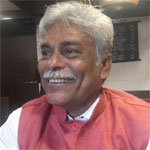The Jeff Goldberg Studio, Khar, is a unique Mumbai-based theatre group that manages to mount productions of the latest plays like The David Coleman Headley Story, as well as modern classics like Sakharam Binder and Aadhe Adhure. Last week, an outstanding performance of Aadhe Adhure was put up at their Khar Road intimate theatre.
The late Mohan Rakesh was the leading light of a new wave theatre that hit India in the swinging 60s. Aadhe Adhure was written in 1969, and this year happens to be its golden jubilee year. The play is still, or is perhaps, even more relevant today.
Mohan Rakesh (1925-1972) was a multi-talented writer who moved easily between different genres like novels, plays, and short stories. He taught Hindi literature for a while and edited Sarika for some time. His first modern Hindi play Ashad Ka Ek Din had won a competition organised by Sangeet Natak Akademi in 1958. In Aadhe Adhure, Mohan Rakesh narrates a story of a family caught in the web of destitution. It is a family of five members, husband (Mahinder), wife (Savitri), elder daughter (Binny), son (Ashok) and youngest daughter (Kinni).
The plot
The play opens with a ‘man in a black suit’ whose face is hidden in darkness. He does not want to face light as he represents the middle-class Indian of the urban India of the 1960s when women had just stepped into the job market. He tells the audience that he is one of the millions whom we meet on the road every day. He has no claim to fame, and is trying hard to meet both ends. His diction is barely audible as it also represents the voiceless Indians.
The entire story takes place in the untidy drawing room of Mahinder’s home. This untidiness parallels the lives of the members of Mahinder’s family. At the extreme left corner Mahinder sits with no hope in life and Savitri walks in, tired after a day’s hard work at office. She expects somebody to greet her with a glass of water, and perhaps a cup of hot tea. Since no one is home (so she feels) she helps herself, but slowly realises that there is Mahinder in the drawing room, Ashok is in the bedroom, and yet nobody extends this simple courtesy towards her. Irritated, she fires the first salvo. This verbal duel that follows between Mahinder and Savitri conveys to the audience that this is an everyday affair in this family. It also brings to the fore the fact that this is a completely dysfunctional family where nobody talks to each other, and when they do, they draw blood!
Savitri is completely frustrated with her husband and other family members. For her, Mahinder is an utter failure who has lost everything in business, and is now good for nothing. Savitri’s meagre salary is the only source of income for the family. She tries all possible ways to set her son up in a good job. With this intention she invites Singhania, her boss, home, with the hope that he can use his contacts to get Ashok a good job. Ashok cannot stand Singhania and is contemptuous of his many habits. Nothing works for Savitri, adding to her frustrations. Add to this the fact that her recently married daughter Binni spends much of her time with her, as she hates her husband. The youngest daughter Kinni is on the verge of puberty and is keenly interested to know more about man-woman relations.
The entire family seems to be caught in a tangle from which nobody can escape. All they can do is to hurt each other continuously, and regularly. Savitri cannot take this anymore. She decides to elope with her old boy friend Jagmohan, but cannot muster up the courage. She continues to sulk and live the same life with no end in sight.
Mohan Rakesh’s play is tautly written, and dialogues are hard-hitting. There is constant tension among the members of the family who at times get physical. This creates a high drama that lasts for over two hours. Komal Chhabria (Savitri) gets under the skin of the character right from the word go, and continues to hold the audience under her spell. Komal has played this role as if it was written just for her. She has managed to convey the frustration of a woman married to a failure, frustrations of a mother who cannot get her children onto the right path, the frustration of a lover who cannot gather the courage to elope with her boy friend.
Ashok Pandey has directed the play as well as played the half a dozen characters effortlessly. He is Mahinder, Juneja, Singhania, and Jagmohan. Of all these, Ashok slips into the character of Mahinder smoothly. His drooping shoulders, his slow and defeated diction, tells us everything about this unsuccessful man. These two main characters are ably assisted by Arjun Tanwar (Ashok), Afshan Khan (Binny), and Urvazi Kotwal (Kinny). Amit Patil has handled the lights and sounds for this play, and Raj Chhabria has designed the set.
I had seen this play about 25 years ago in which the late Dinesh Thakur and Sunila Pradhan played the main characters. I thought to myself then that such dysfunctional families would be rare. Today when I sat through this show, I felt that every second family in urban India resembles the family of Mahinder and Savitri. So much frustration, so much angst. No wonder Aadhe Adhure is rightly hailed as a ‘modern classic’.


 [/column]
[/column]